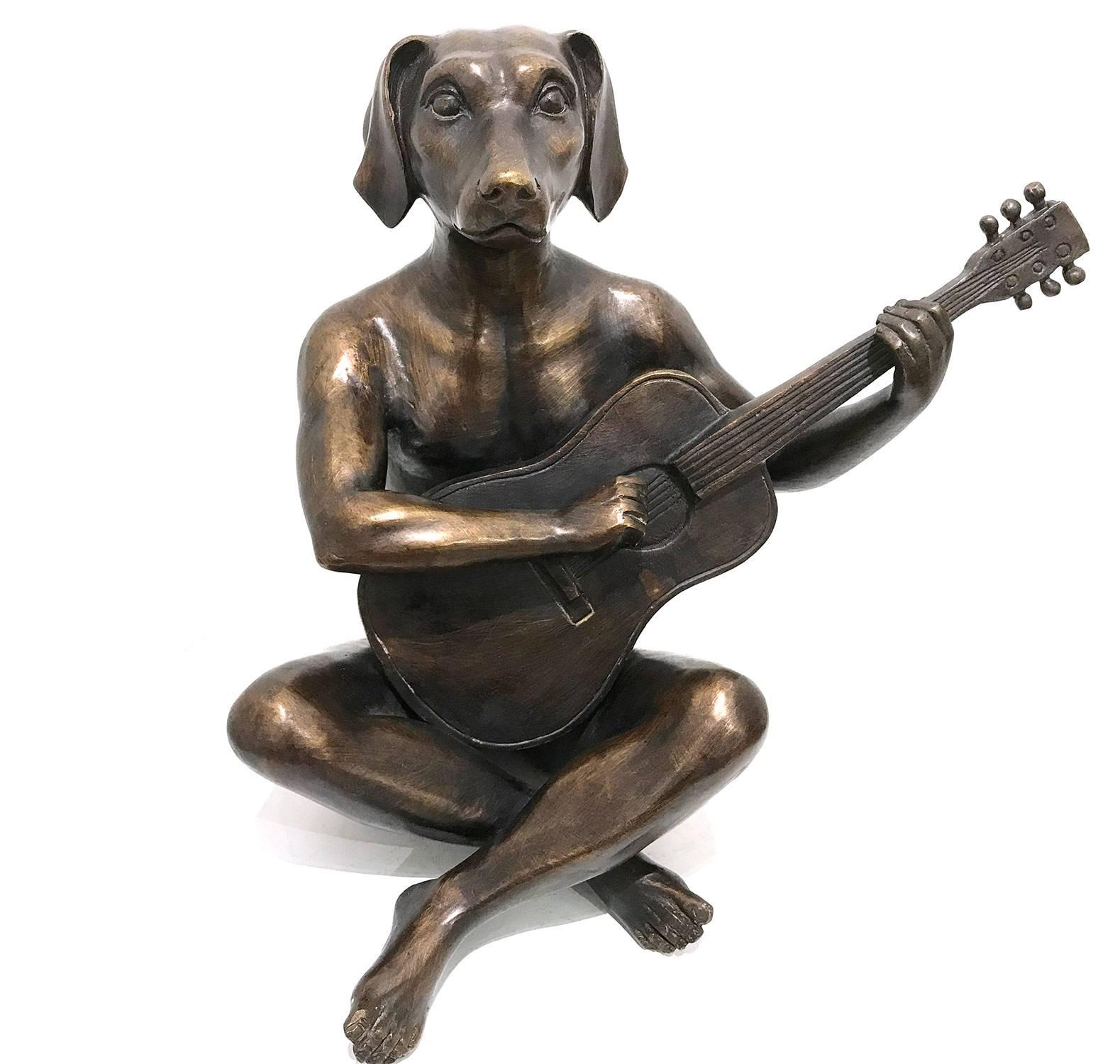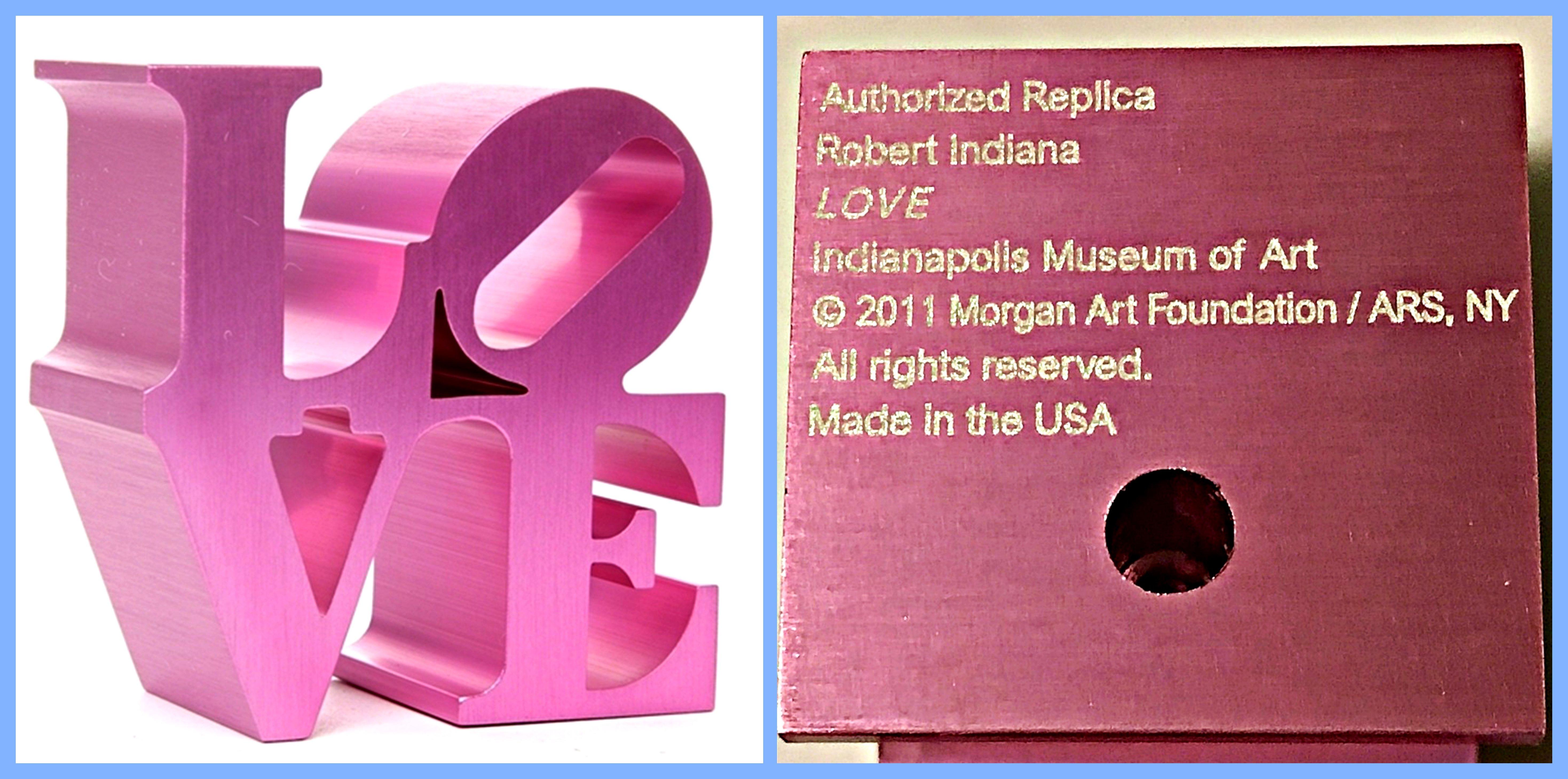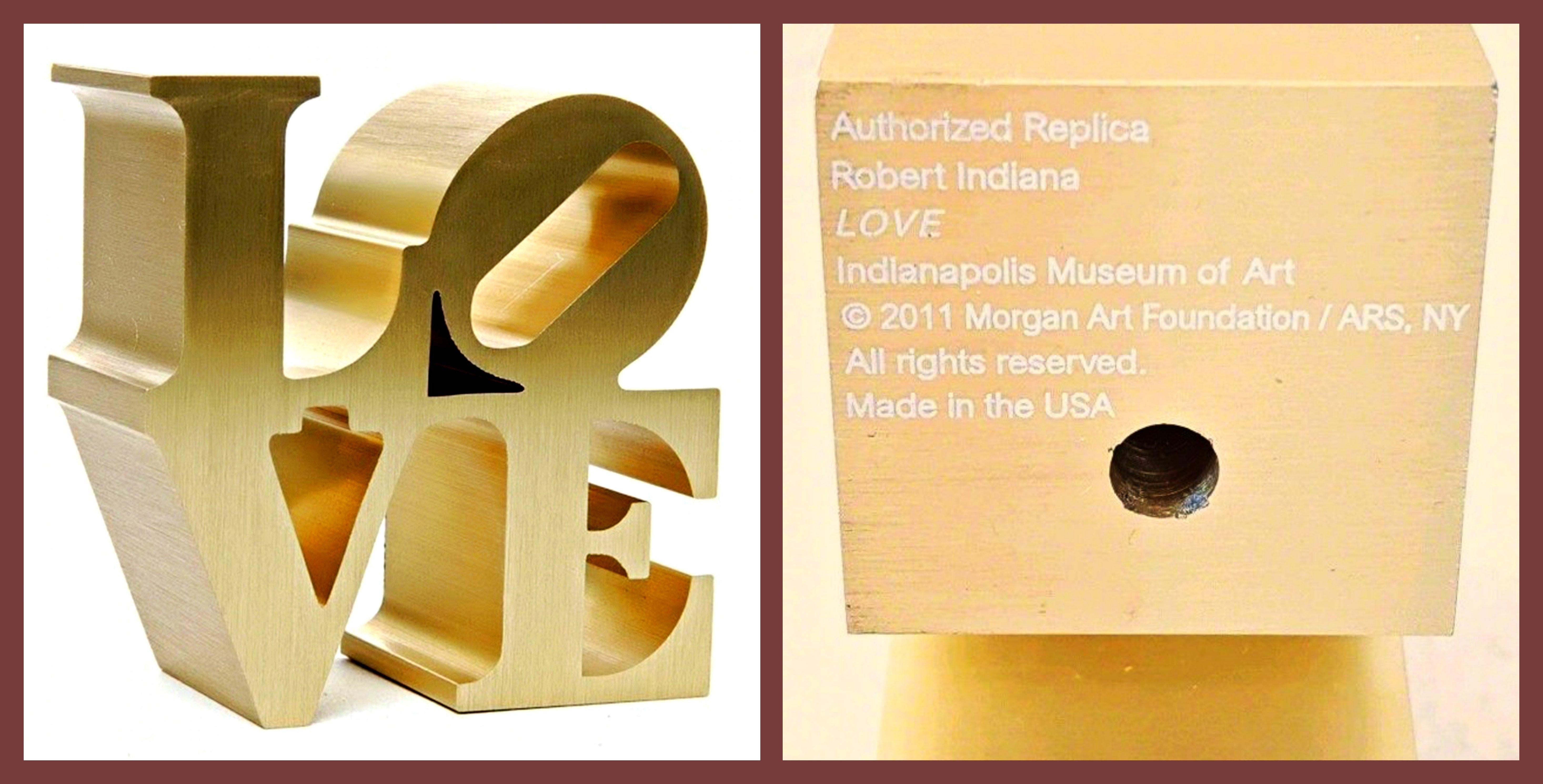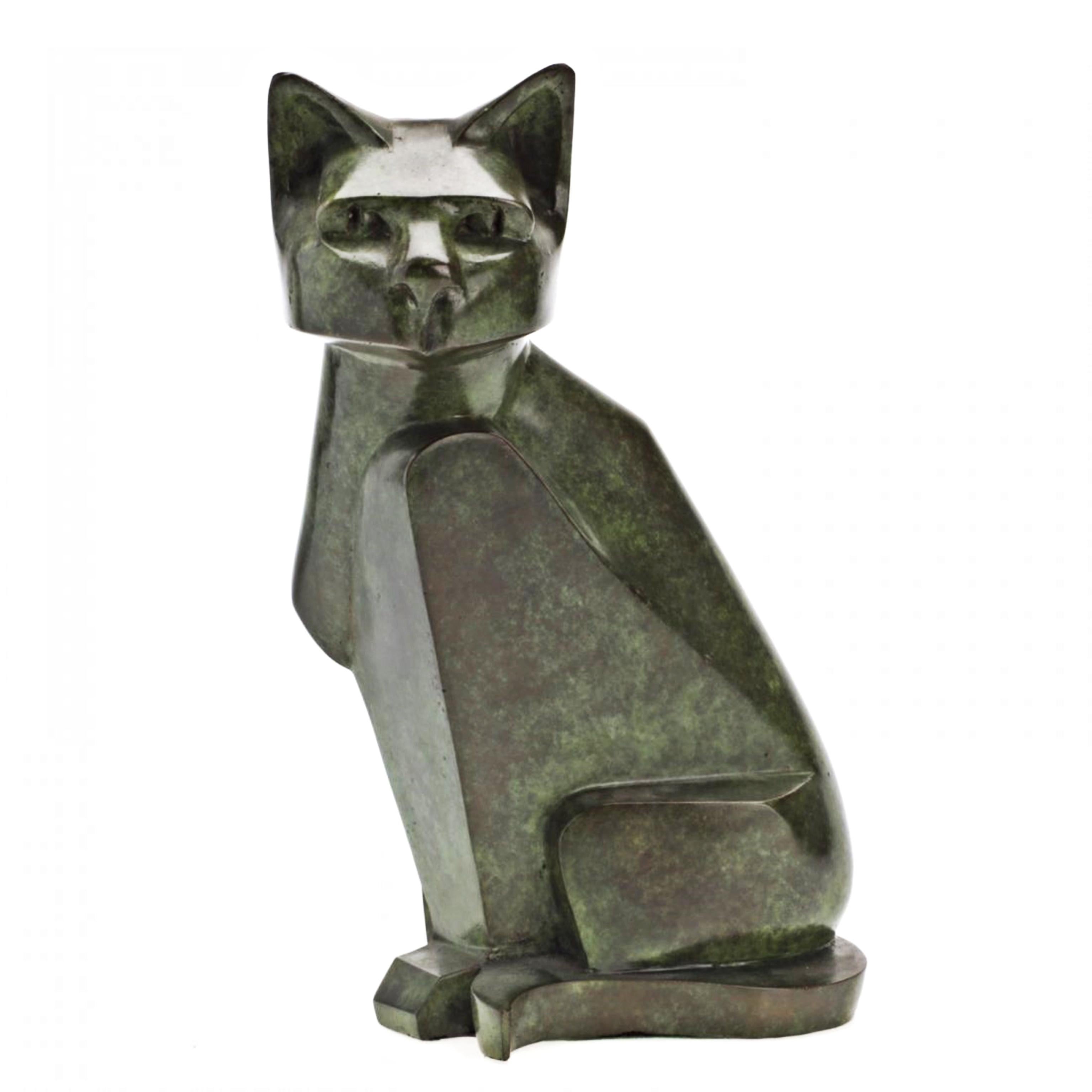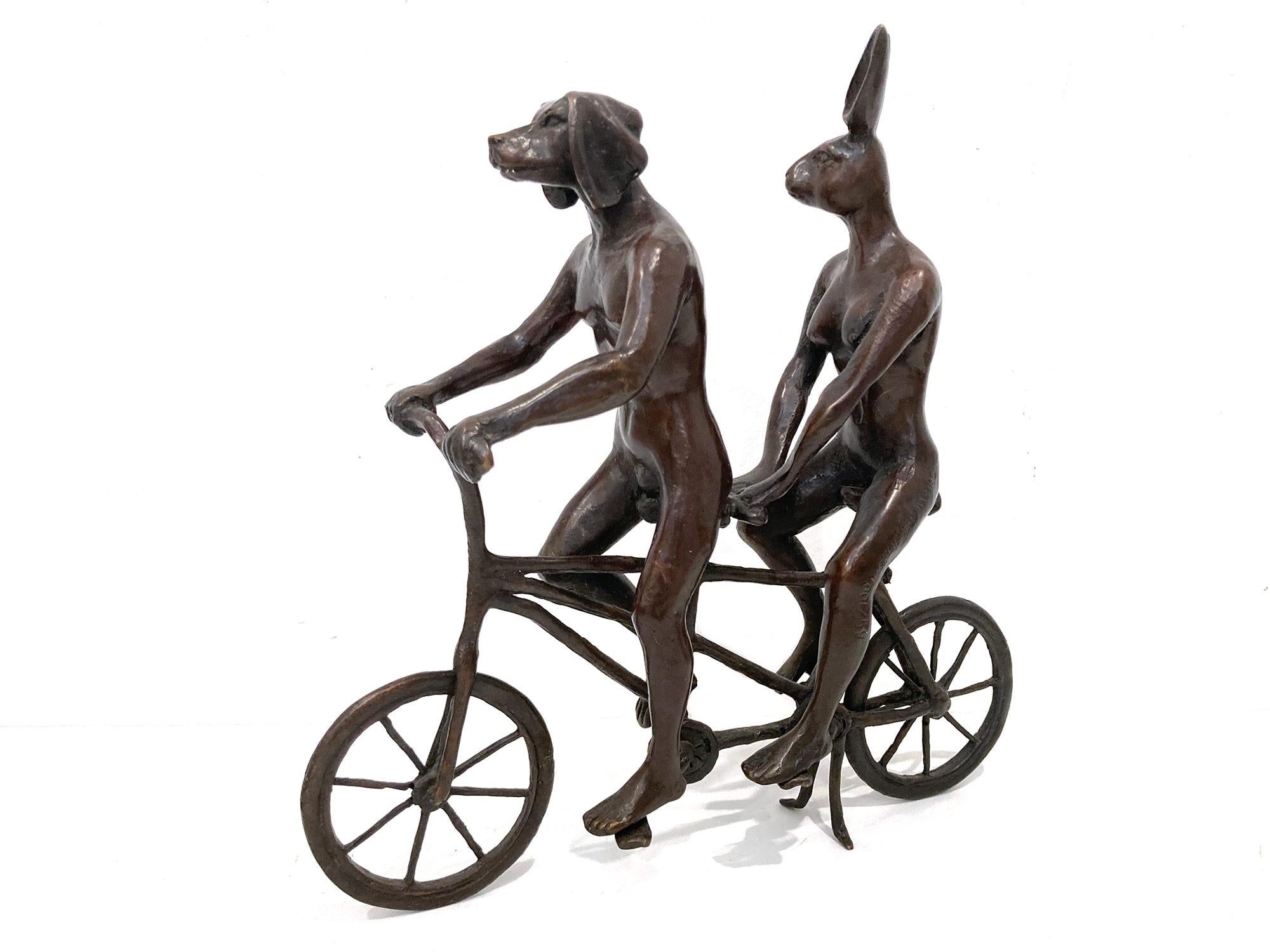Items Similar to Rare Oded Halahmy Cast Sculpture Art Menorah Artisan Judaica in Jewish Museum
Want more images or videos?
Request additional images or videos from the seller
1 of 18
Oded HalahmyRare Oded Halahmy Cast Sculpture Art Menorah Artisan Judaica in Jewish Museum1997
1997
About the Item
Oded Halahmy (Iraqi-Israeli, b. 1938)
Bronze and aluminium
"Peace Shalom Salaam" Hanukkah/ Chanukah menorah, 1997
The base signed on one side with his stamped initials, "O.H. © 97."
This simple pomegranate menorah by Iraqi artist Oded Halahmy is made from cast aluminum and bronze or brass with a polished patina. The menorah sits on two pedestals. Smaller pomegranates on the top function as the candleholders.
Dimensions: 16 x 2.75 X 8.5
Like countless New Yorkers who arrived from distant lands, Oded Halahmy has a rich personal history of exile, migration, and travels. Born in the old city of Baghdad in 1938, Halahmy came from a family of Orthodox Jews with deep roots in ancient Babylonian culture. Although New York has been his home for over 45 years, memories of Iraq left an indelible imprint on his life and work. Known for his dynamic yet often playful figurative sculptures in wood and bronze, he fills his work with images—albeit abstracted from reality—that evoke the landscape, architecture, and rich colors of the Middle East. Palm trees, doves, pomegranates, temples, and age-old symbols are central themes in his work. Halahmy’s work is included in the collection of the Jewish Museum.
Oded Halahmy, Abstract Modernist artist, was born in Iraq in the old city of Baghdad in 1938, the artist came from a family of Orthodox Jews with deep roots in ancient Babylonian culture. His father, Salech Haskel Chebbazah, was a prosperous goldsmith in Baghdad and a Jewish member of the Communist Party when Jews comprised more than a quarter of the population of Baghdad. He refers to his home as the “land of wheat, barley, grapes, figs, pomegranates, olives and dates.”, Oded moved with his family to Israel in the 1950s, was educated at St. Martin's School of Art in London which was then a leading center for sculpture, led by Anthony Caro and Philip King and having links to Henry Moore. He taught sculpture are in the collection of the Guggenheim Museum, the Hirshhorn Museum, and the Israel Museum in Jerusalem, as well as many other public and private collections worldwide. He currently lives in New York City and Old Jaffa, Israel.
Like countless New Yorkers who arrived from distant lands, Oded Halahmy has a rich personal history of exile, migration and travels. Although New York has been his home for over 45 years, memories of Iraq left an indelible imprint on his life and work. Known for his dynamic yet often playful figurative pop art style sculptures in wood and bronze, he fills his work with images — albeit abstracted from reality — that evoke the landscape, architecture, folk art and rich colors of the Middle East. Palm trees, doves, pomegranates, temples and age-old symbols abound along with deep reds, amber, sky blue and the familiar greenish-blue hues of aged bronze. Halahmy's work is in the permanent collections of the Solomon R. Guggenheim Museum, (New York, NY); Hirshhorn Museum and Sculpture Garden (Washington, DC); Israel Museum (Jerusalem, Israel); Jewish Museum, New York, NY; among others.
SELECTED SOLO EXHIBITIONS
Dates-Pomegranates-Olive Oil: Chanukah Lamps, Yeshiva University Museum, New York, NY
District of Columbia Jewish Community Center Ann Loeb Bronfman Gallery, Washington, D.C.
Homeward: Baghdad - Jerusalem - New York, Sundaram Tagore Gallery, New York, NY
Homelands: Baghdad-Jerusalem-New York, A Retrospective, The Ann Loeb Gallery, Washington,
Homelands: Baghdad-Jerusalem-New York, A Retrospective, Yeshiva University Museum, NY
The Common Ground; The Sculpture Of Oded Halahmy, Sundaram Tagore Gallery, New York, NY
Herr-Chambliss Fine Arts, Hot Springs, AR
Artists Studio, Old Jaffa, Israel
Byer Museum of Art, Evanston, IL
The Aldrich Museum of Contemporary Art, Ridgefield, CT
Tomasulo Gallery, Union College, Cranford, NJ
Martha White Gallery, Louisville, KY
Louis K. Meisel Gallery, New York, NY
New England Center for Contemporary Art, Brooklyn, CT
Hebrew Union College, New York, NY
Bicentennial Tribute, United States Federal Plaza, New York, NY
Horace Richter Galleries, Jaffa, Israel, 1976
Parsons School of Design, New York, NY
America-Israel Culture House, New York, NY
Herbert F. Johnson Museum of Art, Cornell University, Ithaca, NY
Louis K. Meisel Gallery, New York, NY
Gallery Moos, Toronto, Canada
Old Jaffa Gallery, Jaffa, Israel
Pollack Gallery, Toronto, Canada
SELECTED GROUP EXHIBITIONS
2006 Iraqi Art Today, Pomegranate Gallery, New York, NY
2003 Iraqi Art Now, DePaul University Art Gallery, Chicago, IL
2002 The Nude In Three Dimensions, Louis K. Meisel Gallery, New York, NY Iraqi Art and Literature Around the World, Grinnell College, Grinnell,
1989 Israel Museum, Jerusalem, Israel
1988 Art at the Armory, New York, NY
1987 The New Generation, Elaine Benson Gallery, Bridgehampton, NY
1983 Louis K. Meisel Gallery, New York, NY
1982 Galerie Isy Brachot, Brussels, Belgium
1981 Marisa Del Re Gallery, New York, NY
1978-1981 Sid Deutsch Gallery, New York, NY
1979 The Aldrich Museum of Contemporary Art, Ridgefield, CT
1977 Alexander F. Milliken Gallery, New York, NY
Monique Knowlton Gallery, New York, NY
1976 Faculty Exhibition, Parsons School of Design, New York, NY
1976 Robert Elkon Gallery, New York, NY
Bonino Gallery, New York, NY
1974 Gruenebaum Gallery, New York, NY
Herbert F. Johnson Museum of Art, Cornell University, Ithaca, NY
International Sculpture Show, Gallery Moos, Toronto, Canada
Ten from America International Sculpture Symposium, New York, NY
1973-1986 Horace Richter Galleries, Jaffa, Israel
1973 Queens Museum, Queens, NY
1972 American International Sculpture Symposium, New York, NY
1970 Alwin Gallery, London, England
The Tel Aviv Museum, Helena Rubinstein Pavilion, Tel Aviv, Israel
1968 The Montreal Museum of Fine Arts, Montreal, Canada
1967 London Group, London, England
The Mayor Gallery, London, England
Grosvenor Gallery, London, England
Ben Uri Gallery, London, England
And the pomegranates bud forth: The Pomegranate in Israel Art
Mayanot Gallery, Jerusalem, 1991
Artists: Raban, Ze'ev Rabinovitz, Israel Naaman, Michal Gerstein, David (Dudu) Halachmi, Oded Ofek, Avraham Bergner, Yosl Streichman, Yehezkel Abramovich, Pinchas Mairovich, Zvi Janco, Marcel Gliksberg, Haim Gutman, Nachum Rubin, Reuven Ovadyahu, Shmuel Schatz, Boris Yemini, Yihye
The Autumn Exhibition - Israeli Artists The Autumn Exhibition - Israeli
Tel Aviv Museum of Art, Helena Rubinstein Pavilion, Tel Aviv
28 September, 1970 - 7 November, 1970
Artists: Evyatar, Hena Uri, Aviva Eizemann, Michael Rita, Alima Beeri, Tuvia Byle, John BarEl, Yoav Geva, Avital Granoth, Yeshayahu Gershuni, Moshe Halevi, Joseph Halachmi, Oded Hack, Kalman Wexler, Yaacov Tolkovsky, Zvi Yardeni, Yehezkel Lavie, Raffi Lieblich, Ziva Merhav, Shimshon Neustein, Joshua Oz, Dida Eshet, Pinchas Peralta, Daniel Propes, Moshe Kiewe, Chaim Shavit, Amichai (Ami) Schwartz, Buky Shelesnyak, Henry Shenbar, Baruch Tick, Gad
1967: The Americanization of Israeli Art 1967: The Americanization of Israeli Art
Bograshov Gallery, Tel Aviv
Ha' Kibbutz, Israeli Art Gallery, Tel Aviv
2 September, 1989 - 23 September, 1989
Artists: Abramovich, Pinchas Ullman, Gad Ullman, Micha Uri, Aviva Ayal, Avishay Rita, Alima Argov, Michael Aroch, Arie Batlle, Georgette Ben Shaul, David (Dedi) Brown, Aika (Ariel) BarEl, Yoav Kadim (Berman), Reuven Gaon, Izzika Givati, Moshe Garbuz, Yair Gershuni, Moshe Dorchin, Yaacov Druks, Michael Witkin, Aaron Weinfeld, Yocheved (Juki) Tolkovsky, Zvi Tartakover, David Yardeni, Yehezkel Kahana, Aharon Lavie, Raffi Lieblich, Ziva Lifschitz, Uri Neustein, Joshua Eshet, Pinchas Feingersh, Oded Propes, Moshe Cizik, Milka Kadishman, Menashe Kiewe, Chaim Kilemnik, Arie Ron, Ziva Schwebel, Ivan Schwartz, Buky Shechori, Ran Shelesnyak, Henry Shemi, Yehiel Shatz, Shaul Tumarkin, Igael Byle, John Hack, Kalman Halachmi, Oded Rozov, Joram
- Creator:Oded Halahmy (1938)
- Creation Year:1997
- Dimensions:Height: 8.5 in (21.59 cm)Width: 16 in (40.64 cm)Depth: 2.75 in (6.99 cm)
- Medium:
- Movement & Style:
- Period:
- Condition:good. minor wear at corners and a couple of minor scuffs. please see photos.
- Gallery Location:Surfside, FL
- Reference Number:1stDibs: LU38213711222
About the Seller
4.9
Platinum Seller
These expertly vetted sellers are 1stDibs' most experienced sellers and are rated highest by our customers.
Established in 1995
1stDibs seller since 2014
1,560 sales on 1stDibs
Typical response time: 1 hour
- ShippingRetrieving quote...Ships From: Surfside, FL
- Return PolicyA return for this item may be initiated within 3 days of delivery.
More From This SellerView All
- Mexican Art Abstract Brutalist Biomorphic Bronze Sculpture Mathias GoeritzBy Mathias GoeritzLocated in Surfside, FLMathias Goeritz (German Mexican, 1915-1990) Bronze sculpture Signed and numbered Dimensions: (approximate) Height: 10 inches, Width: 4 inches, Depth: 2 inches. This is a cast bronze sculpture in an amorphous figure shape, quite heavy. Reminiscent of the biomorphic sculpture of Hans Jean Arp. This came from an estate and bears his signature It is not dated. there is no accompanying documentation. it is priced accordingly. Werner Mathias Goeritz Brunner (Danzig, Germany, April 4th, 1915/ now Gdansk, Poland – Mexico City, Mexico; August 4th, 1990). Mathias Goeritz has had several gallery and museum exhibitions, including at the Museo Nacional Centro de Arte Reina Sofía and at the Museo Experimental El Eco. Numerous works by the artist have been sold at auction, including 'MENSAJE' sold at Sotheby's New York 'Latin American Modern Art' in 2015 for $466,000. There have been Several articles about Mathias Goeritz, including 'LACMA remaps Latin America' written by Suzanne Muchnic for the Los Angeles Times. Painter, sculptor and Mexican architect associated with the trend of constructive abstraction. He studied medicine at the University of Berlin, but this only lasted a year. The concerns of the young student were aesthetic in nature so he he studied figurative drawing at the Berlin Charlottenburg School of Art. Some of his friends and colleagues were the sculptor Ernst Barlach, painter George Grosz and draughtsman Kaethe Kollwitz. Goeritz studied philosophy and history of art, discipline in which earned a doctorate. He travelled in France, Switzerland, Czechoslovakia, Poland, Austria and Italy, among other countries. It is known that he left Germany to live in Tetuan, Morocco in 1941 and then Granada, Spain in 1945. In 1946 he had a large exhibition in the Sala Clan in Madrid under the pseudonym "Mago". Two years later, living in Santilla del Mar, Spain he was a founder of the Escuela de Altamira. The following year he married Marianne Gast, writer and his companion for more than fifteen years. In Spain followed his artistic work by important artists of the avant-garde. Of Jewish descent, he found refuge from the Second World War in Mexico where in 1949 he was invited by Ignacio Diaz Morales to be a part of the faculty of the School of Architecture at the Universidad de Jalisco. In 1953 he wrote the "Manifiesto de la Arquitectura Emocional" (The Emotional Architecture Manifesto), where he points out that only achieving true emotions from architecture can it then be considered an art form. In Mexico he entered controversy with the artistic stablishment of that country; in an open letter, Diego Rivera and David Alfaro Siqueiros described him as "an impostor without the most insignificant talent and preparation" to be an artist. Despite this, in 1957 he was elected director of visual design of the National School of architecture This same year he founded the Museo del Eco in Mexico City. In 1961 Goeritz participated at the Galería Antonio Souza in a group exhibition, Los hartos, for which he published another manifesto. Other participants included Jose Luis Cuevas and Pedro Friedeberg, with whom he was instrumental in establishing abstraction and other modern trends in Mexico.His work is included in the Gelman Collection of modern and contemporary Mexican art based in Cuernavaca, Mexico. Established by Jacques and Natasha Gelman in 1943 as a private collection. it includes many iconic works by major Mexican Modernists including Frida Kahlo, Diego Rivera, David Alfaro Siqueiros, Leonora Carrington, Rufino Tamayo and Francisco Toledo, Lola Alvarez...Category
20th Century Modern Abstract Sculptures
MaterialsBronze
- Brutalist Hand Forged Iron Mosaic Sculpture Menorah Israeli David PalomboBy David PalomboLocated in Surfside, FLHand Forged Iron Stone Mosaic Hanukah Menorah Candelabra David Palombo was an Israeli sculptor and painter. He was born in Turkey to a traditional family and immigrated to the Land of Israel with his parents in 1923. They lived in the Nahalat Shiva neighborhood of Jerusalem. In 1940 he began his studies at Bezalel Academy of Arts and Design, and from 1942 was a student of sculptor Ze’ev Ben-Zvi. For a period of time, Palombo was an assistant at Ben-Zvi’s studio and also taught at Bezalel. During this period he was also a member of the “Histadrut HaNoar HaOved VeHaLomed” (The General Federation of Students and Young Workers in Israel). In the 1940s he took art lessons at night. In 1948 he went to Paris, where he visited the studio of the sculptor Constantin Brancusi whose work influenced him. Around 1958 he married the artist Shulamit Sirota. In 1960 he quit his job to devote himself to art. In 1964 he married for the second time to the artist Yona Palombo. The two of them went to live in an abandoned home on Mount Zion in Jerusalem. In 1966 he was killed when the motorcycle on which he was riding ran into a chain stretched across the street to prevent the desecration of Shabbat. His widow opened a museum in their home that was active until the year 2000. Work by Palombo is included in the Judaic collection of the Jewish Museum (a well known Hanukkah menora). Palombo executed the impressive metal gates of the Tent of Remembrance at the Yad Vashem, the memorial to the martyrs of the holocaust, as well as the gates to the Knesset Building the United Nations Educational Scientific and Cultural Organization (Unesco award) awarded him a scholarship for study in Japan. He worked in marble, granite, bronze, iron and steel. as well as with glass mosaic tiles. Palombo’s early works, in the 1950s, were influenced by modernist sculptors such as Brancusi. These works were composed of abstract images from nature and were carved out of stone or wood. At the end of the 1950s he began making metal sculptors, using the technique of welding. His work took on a more abstract and expressive character. Education 1940 Painting with Isidor Ascheim, New Bezalel School for Arts and Crafts, Jerusalem 1942 Sculpture with Zeev Ben Zvi, Jerusalem 1956 Mosaic, Ravenna, Italy 1958 Welding Course Awards And Prizes 1966 UNESCO Award Exhibitions: Sculpture in Israel, 1948-1958 Mishkan Museum of Art, Kibbutz Ein Harod Artists: Zvi Aldouby, Yitzhak Danziger, Arieh Merzer, Dov Feigin, Aaron Priver, David Palumbo, Menashe Kadishman, Kosso Eloul, Yehiel Shemi, Zahara Schatz. The Spring Exhibition of Jerusalem Artists, Artists' House, Jerusalem Artists: Palombo, David Bezalel Schatz, Mordechai Levanon, Fima, Ludwig Blum 12 Artists, The Bezalel National Museum, Jerusalem Avraham Ofek, Aviva Uri, Avigdor Arikha, Yosl Bergner, Lea Nikel, Palombo, Ruth Zarfati...Category
Mid-20th Century Arte Povera Abstract Sculptures
MaterialsStone, Iron
- French Pop Art Heavy Bronze Sculpture Chess Game Gambit Arman AccumulationBy ArmanLocated in Surfside, FLArman, French American (1928-2005) Gambit (Chess pieces) Cast Bronze Sculpture with patina Incised signature near lower edge, 48/70 with impressed "Bronze Romain & Fils" foundry ma...Category
Early 2000s Abstract Figurative Sculptures
MaterialsBronze
- Bronze Sculpture Abstract Brutalist Goat or Ram WPA Artist Mounted on BaseBy Benedict Michael TattiLocated in Surfside, FLBenedict Tatti (1917-1993) worked in New York city as a sculptor, painter, educator, and video artist. He studied stone and wood carving under Louis Slobodkin at the Roerich Museum. He later attended the Leonardo da Vinci School of Art studying under Attilio Piccirelli. In l939 he taught adult classes with the Teachers Project of the WPA and attended the Art Students League for three and a half years on full scholarship. He studied under William Zorach and Ossip Zadkine and later became Zorach’s assistant. Later in his career, he attended the Hans Hofmann School of Fine Arts. During World War II, Tatti served in the United States Army Air Force, where he spent three years assigned to variety of projects. In 1948, Benedict Tatti married Adele Rosenberg in New York City. Throughout his career, Tatti continuously experimented with various media. From 1952-1963, Tatti executed sculptural models of architectural and consumer products for the industrial designers, Raymond Loewy Associates; later he became a color consultant for the firm. In the 1960s, influenced by the Abstract Expressionists, Tatti turned from carving directly in wood and stone to creating assemblage architecture sculptures, using bronze metal and other industrial materials. He was included in the important show "Aspects de la Sculpture Americaine", at Galerie Claude Bernard Paris, France, in October 1960 along with Ibram Lassaw, Theodore Roszak, David Smith, Louise Bourgeois, Danese Corey, Dorothy Dehner, Lin Emery...Category
Mid-20th Century Abstract Expressionist Abstract Sculptures
MaterialsBronze
- Large Aharon Bezalel Israeli Modernist Bronze Brutalist Puzzle Sculpture FiguresBy Aharon BezalelLocated in Surfside, FLAharon Bezalel (Afghani-Israeli, 1925-2012) Family Grouping Hand signed in with initials in English Figures fit together like puzzle pieces in solid cast bronze with original patina. Aharon Bezalel (born Afghanistan 1926) Born in Herat, Afghanistan in 1926 and immigrated to Israel at an early age. His father, Reuven Bezalel, was a rabbi and kabbalist. As a youth Aharon studied gold and silver casting as well as applied arts and worked in these fields as a silversmith and judaica craftsman, and was a student of the sculptor Zev Ben-Zvi at the Bezalel Academy for Art & Design where he also studied with Isidor Ascheim and Mordecai Ardon. There he absorbed the basic concepts of classic and modernist art and interpreted, according to them, ideas based on ancient Hebrew sources. He also studied miniature carving with the artists Martin and Helga Rost applying himself at their workshop. Aharon Bezalel worked and resided in Jerusalem, he taught art for many years. His sculptures - works of wood, bronze, aluminum, Plexiglas - were shown at his studio in Ein Kerem. “I saw myself as part of this region. I wanted to find the contact between my art and my surroundings. Those were the first years of Jean Piro’s excavations at the Beer-Sheba mound. They found there, for example, the Canaanite figurines that I especially liked and that were an element that connected me with the past and with this place.” “…a seed and sperm or male and female. These continue life. The singular, the individual alone, cannot exist; I learned this from my father who dabbled with the Kabbalah.” (Aharon Bezalel, excerpt from an interview with David Gerstein) “The singular in Aharon Bezalel’s work is always potentially a couple if not a threesome, the one is also the many: when the individual is revealed within the group he will always seek a huddling, a clinging together. The principle of modular construction is required by this perception of unity and multiplicity, as modular construction in his work is an act of conception or defense. His work bears a similarity to Berrocal as well as affinities to Henry Moore, Lynne Chadwick and Kenneth Armitage. Two poles of unity, potentially alone, exist in A. Bezalel’s world: From a formal, sculptural sense these are the sphere and pillar, metaphorically these are the female in the final stages of pregnancy and the solitary male individual. Sphere-seed-woman; Pillar-strand-man. The disproportional, small heads in A. Bezalel figures leave humankind in it’s primal physical capacity. The woman as a pregnancy or hips, the man as an aggressive or defensive force, the elongated chest serves as a phallus and weapon simultaneously. (Gideon Ofrat) EIN HAROD About the Museum's Holdings: Israeli art is represented by the works of Reuven Rubin, Zaritzky, Nahum Gutman...Category
Mid-20th Century Expressionist Abstract Sculptures
MaterialsBronze
- The Test, Assembled Kinetic Modernist Sculpture Puzzle ConstructionBy William King (b.1925)Located in Surfside, FL"The Test," 1970 Aluminum sculpture in 5 parts. Artist's cipher and AP stamped into male figure, front, 20 5/16" x 12 1/2" x 6 5/7" (approx.) American sculptor King is most noted for his long-limbed figurative public art sculptures depicting people engaged in everyday activities such as reading or conversing. He created his busts and figures in a variety of materials, including clay, wood, metal, and textiles. William Dickey King was born in Jacksonville, Florida. As a boy, William made model airplanes and helped his father and older brother build furniture and boats. He came to New York, where he attended the Cooper Union and began selling his early sculptures even before he graduated. He later studied with the sculptor Milton Hebald and traveled to Italy on a Fulbright grant. Mr. King worked in clay, wood, bronze, vinyl, burlap and aluminum. He worked both big and small, from busts and toylike figures to large public art pieces depicting familiar human poses — a seated, cross-legged man reading; a Western couple (he in a cowboy hat, she in a long dress) holding hands; a tall man reaching down to tug along a recalcitrant little boy; a crowd of robotic-looking men walking in lock step. Mr. King’s work often reflected the times, taking on fashions and occasional politics. In the 1960s and 1970s, his work featuring African-American figures (including the activist Angela Davis, with hands cuffed behind her back) evoked his interest in civil rights. But for all its variation, what unified his work was a wry observer’s arched eyebrow, the pointed humor and witty rue of a fatalist. His figurative sculptures, often with long, spidery legs and an outlandishly skewed ratio of torso to appendages, use gestures and posture to suggest attitude and illustrate his own amusement with the unwieldiness of human physical equipment. His subjects included tennis players and gymnasts, dancers and musicians, and he managed to show appreciation of their physical gifts and comic delight at their contortions and costumery. His suit-wearing businessmen often appeared haughty or pompous; his other men could seem timid or perplexed or awkward. Oddly, or perhaps tellingly, he tended to depict women more reverentially, though in his portrayals of couples the fragility and tender comedy inherent in couplehood settled equally on both partners. His first solo exhibit took place in 1954 at the Alan Gallery in New York City. King was elected to the American Academy of Arts and Letters in 2003, and in 2007 the International Sculpture Center honored him with the Lifetime Achievement in Contemporary Sculpture Award. Mr. King’s work is in the collections of the Metropolitan Museum of Art, Guggenheim Museum, Whitney Museum and the Museum of Modern Art in New York and the Hirshorn Museum at the Smithsonian American Art Museum in Washington, among other places, and he had dozens of solo gallery shows in New York and elsewhere. Reviews of his exhibitions frequently began with the caveat that even though the work was funny, it was also serious, displaying superior technical skills, imaginative vision and the bolstering weight of a range of influences, from the ancient Etruscans to American folk art to 20th-century artists including Giacometti, Calder and Elie Nadelman. The New York Times critic Holland Cotter once described Mr. King’s sculpture as “comical-tragical-maniacal,” and “like Giacomettis conceived by John Cheever.”Category
1970s American Modern Figurative Sculptures
MaterialsMetal
You May Also Like
- "He Played Like He Was Keith Richards" Dogman with Guitar Bronze SculptureBy Gillie and Marc SchattnerLocated in New York, NYA whimsical yet very strong piece depicting the Dog Man from Gillie and Marc's iconic figures of the Dog/Bunny Human Hybrid, which has picked up much esteem across the globe. Here we...Category
2010s Pop Art Abstract Sculptures
MaterialsBronze
- LOVE (Pink) sculpture, official replica with Indianapolis Museum of Art stampBy Robert IndianaLocated in New York, NYRobert Indiana LOVE (Pink), Artist Authorized, with Incised Indianapolis Museum of Art & Morgan Foundation Stamp and Artist Copyright, 2011 Brushed Aluminum (Pink) and Stamped with M...Category
2010s Pop Art Figurative Sculptures
MaterialsMetal
- EIGHT (SCULPTURE)By Robert IndianaLocated in Aventura, FLEnamel and steel sculpture. Measures 18 x 18 x 10 inches (with base). Stamped 'R. Indiana' with edition, date and foundry. Edition 2/8. Artwork is in excellent condition. All ...Category
Early 2000s Pop Art Abstract Sculptures
MaterialsMetal
- LOVE (Authorized replica, official stamp of Indianapolis Museum of Art & artist)By Robert IndianaLocated in New York, NYRobert Indiana LOVE (Sculpture Stamped with Indianapolis Museum and Artist Stamp), 2009 Brushed Aluminum (Gold) Stamped with Artist's Copyright & Indianapolis Museum of Art/2011 Morgan Art Foundation/ARS, NY Stamped/incised w/text: "Authorized Replica/Robert Indiana/LOVE/Indianapolis Museum of Art/2011 Morgan Art Foundation/ARS, NY 3 × 3 × 1 1/2 inches Unframed Since first appearing on the Museum of Modern Art’s 1965 Christmas card, Robert Indiana’s “LOVE” quickly permeated the popular imagination, appearing everywhere from life-size sculptures to government-issued stamps. The design’s appeal was timeless, yet also emblematic of the idealistic and free-loving 1960s. As art legend has it, Indiana was first bemused and later conflicted about the instant runaway success of his design, worried that it may have ruined his reputation among the art world elite as a one-hit wonder. Despite the artist’s private insecurities, “LOVE” remains one of the most treasured works in 20th-century American sculpture—breaking $4.1 million at auction in 2011. Another edition from this authorized, artist approved series recently sold at Christie's in Paris for over $12,000. LOVE (Limited Edition Artist Authorized, with Incised Indianapolis Museum of Art & Morgan Foundation Stamp and Artist Copyright). This is a limited edition artist authorized miniature of the Indianapolis Museum of Art's giant outdoor...Category
Early 2000s Pop Art Figurative Sculptures
MaterialsMetal
- CAT Catalogue Raisonne Ref: Knight, CR-406 cast bronze sculpture by famed artistBy Gerald LaingLocated in New York, NYGerald Laing Cat, 1983 Cast bronze (hollow core cast) Bears artists full incised signature, artist's copyright logo, as well as stamped signature on the front, Edition 1/9 13 1/2 × 8 3/4 × 6 1/2 inches A magnificent cast bronze sculpture, rarely seen on the market by Gerald Laing, one of the leading British artists of his generation. Catalogued as CR-406 in the 2017 Catalogue Raisonne published by Lund Humphries and the Estate of Gerald Laing. One of only nine editions. This work was acquired from the Estate of distinguished Pop Art collector Arthur C. Carr of Columbia University , who befriended many of the artists whose works he collected. Editions of this work were exhibited in the following venues: GERALD LAING: SCULPTURE 1968 - 1999 The Fine Art Society 148 New Bond Street London UK 22 March - 15 April 1999 GERALD LAING Albert Totah Gallery 152 Wooster Street New York City New York USA, 24 January - 21 February 1987 GERALD LAING PAINTINGS AND SCULPTURE 1963-1983 Herbert Art Gallery Jordan Well Coventry UK 10 September - 9 October 1983...Category
1980s Pop Art Abstract Sculptures
MaterialsBronze
- "They Loved Riding Together in Paris" Bicycle Sculpture with Deep Bronze PatinaBy Gillie and Marc SchattnerLocated in New York, NYA whimsical yet very strong piece depicting the Rabbit and Weim from Gillie and Marc's iconic figures of the Dog/Bunny Human Hybrid, which has picked up much esteem across the globe....Category
2010s Pop Art Figurative Sculptures
MaterialsBronze
Recently Viewed
View AllMore Ways To Browse
Sculptures In Home
Signed Artisan
Metal Family Sculpture
Sculpture Cast Brass
Fig Art
Metal Sculpture 1989
Artisan House Metal Art
Fine Art Pedestal
Small Art Pedestal
Amber Sculpture
Metal Modernist Sculpture
Olive Tree Sculpture
Grape Sculpture
White Pedestal Art
Dove Sculpture
Canadian Artisans
White Pedestal With Sculpture
Metal Sculpture Pedestal
